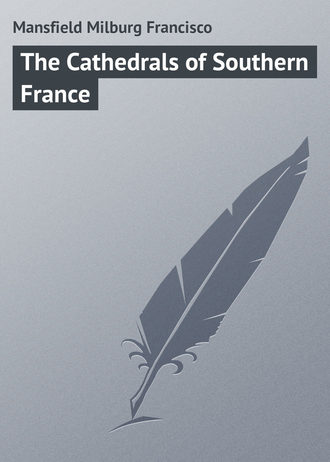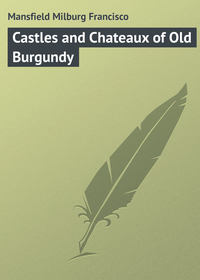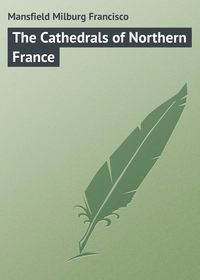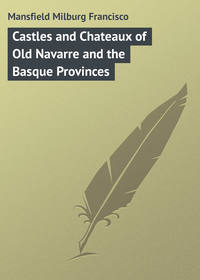 полная версия
полная версияThe Cathedrals of Southern France
From the fact that it is the chief town of the Départment des Pyrénêes-Orientales, it perhaps justifies the procedure. But it is as the ancient capital of Rousillon – only united with France in 1659 – that the imaginative person will like to think of it – in spite of its modern cafés, tram-cars, and magazins.
Like the smaller and less progressive town of Elne, Perpignan retains much the same Catalonian flavour of "physiognomy, language, and dress;" and its narrow, tortuous streets and the jalousies and patios of its houses carry the suggestion still further.
The Treaty of the Pyrenees in 1659 changed the course of the city's destinies, and to-day it is the fortress-city of France which commands the easterly route into Spain.
The city's Christian influences began when the see was removed hither from Elne, where it had been founded as early as the sixth century.
The cathedral of St. Jean is a wonderful structure. In the lines of its apside it suggests those of Albi, while the magnitude of its great strongly roofed nave is only comparable with that of Bordeaux as to its general dimensions. The great distinction of this feature comes from the fact that its Romanesque walls are surmounted by a truly ogival vault. This great church was originally founded by the king of Majorca, who held Rousillon in ransom from the king of Aragon in 1324.
The west front is entirely unworthy of the other proportions of the structure, and decidedly the most brilliant and lively view is that of the apside and its chapels. There is an odd fourteenth-century tower, above which is suspended a clock in a cage of iron.
The whole design or outline of the exterior of this not very ancient cathedral is in the main Spanish; it is at least not French.
This Spanish sentiment is further sustained by many of the interior accessories and details, of which the chief and most elaborate are an altar-screen of wood and stone of great magnificence, a marble retable of the seventeenth century, a baptismal font of the twelfth or thirteenth century, some indifferent paintings, the usual organ buffet with fifteenth-century carving, and a tomb of a former bishop (1695) in the transept.
The altars, other than the above, are garish and unappealing.
A further notable effect to be seen in the massive nave is the very excellent "pointed" vaulting.
There are, close beside the present church, the remains of an older St. Jean – now nought but a ruin.
The Bourse (locally called La Loge, from the Spanish Lonja) has a charming cloistered courtyard of a mixed Moorish-Gothic style. It is well worthy of interest, as is also the citadel and castle of the King of Majorca. The latter has a unique portal to its chapel.
It is recorded that Bishop Berengarius II. of Perpignan in the year 1019 visited the Holy Sepulchre at Jerusalem, and on his return built a church or chapel on similar lines in memory of his pilgrimage. No remains of it are visible to-day, nor can it be further traced. Mention of it is made here from the fact that it seems to have been a worthy undertaking, – this memorial of a prelate's devotion to his faith.
XIV
STE. EULALIA D'ELNE
Elne is the first in importance of the dead cities which border the Gulf of Lyons.
It is the ancient Illiberis, frequently mentioned by Pliny, Livy, and, latterly, Gibbon.
To-day it is ignored by all save the commis voyageur and a comparatively small number of the genuine French touristes.
Formerly the ancient province of Rousillon, in which Elne is situated, and which bordered upon the Spanish frontier, was distinctly Spanish as to manners and customs. It is, moreover, the reputed spot where Hannibal first encamped after crossing the Pyrenees on his march to Rome.
Like Bayonne, at the other extremity of the Pyrenean mountain chain, it commanded the gateway to Spain, and even to-day is the real entrance of the railway route to Barcelona, as is Bayonne to Madrid.
Between these two cities, for a distance approaching one hundred and eighty miles, there is scarce a highway over the mountain barrier along which a wheeled vehicle may travel with comfort, and the tiny Republic of Andorra, though recently threatened with the advent of the railway, is still isolated and unspoiled from the tourist influence, as well as from undue intercourse with either France or Spain, which envelop its few square miles of area as does the Atlantic Ocean the Azores.
To-day Elne is no longer the seat of a bishop, the see of Rousillon having been transferred to Perpignan in the fourteenth century, after having endured from the time of the first bishop, Domnus, since the sixth century.
There has been left as a reminder a very interesting and beautiful smaller cathedral church of the early eleventh century.
Alterations and restorations, mostly of the fifteenth century, have changed its material aspect but little, and it still remains a highly captivating monumental glory; which opinion is further sustained from the fact that the Commission des Monuments Historiques has had the fabric under its own special care for many years.
It is decidedly a minor edifice, and its parts are as unimpressive as its lack of magnitude; still, for all that, the church-lovers will find much crude beauty in this Romanesque basilica-planned church, with its dependant cloister of a very beautiful flowing Gothic of the fifteenth century.
The chief artistic treasures of this ancient cathedral, aside from its elegant cloister, are a bénitier in white marble; a portal of some pretensions, leading from the cathedral to its cloister; a fourteen-century tomb, of some considerable artistic worth; and a bas-relief, called the "Tomb of Constans."
There is little else of note, either in or about the cathedral, and the town itself has the general air of a glory long past.
XV
ST. JUST DE NARBONNE
The ancient province of Narbonenses – afterward comprising Languedoc – had for its capital what is still the city of Narbonne. One may judge of the former magnificence of Narbonne by the following lines of Sidonius Apollinaris:
"Salve Narbo potens Salubritate,Qui Urbè et Rure simul bonus Videris,Muris, Civibus, ambitu, Tabernis,Portis, Porticibus, Foro, Theatro,Delubris, Capitoliis, Monetis,Thermis, Arcubus, Harreis, Macellis,Pratis, Fontibus, Insulus, Salinis,Stagnis, Flumine, Merce, Ponte, Ponto,Unus qui jure venere divosLenœum, Cererum, Palem, Minervam,Spicis, Palmite, Poscius, Tapetis."Narbonne is still mighty and healthful, if one is to judge from the activities of the present day; is picturesque and pleasing, and far more comfortably disposed than many cities with a more magnificently imposing situation.
The city remained faithful to the Romans until the utmost decay of the western empire, at which time (462) it was delivered to the Goths.
It was first the head of a kingdom, and later, when it came to the Romans, it was made the capital of a province which comprised the fourth part of Gaul.
This in turn was subdivided into the provinces of Narbonenses, Viennensis, the Greek Alps, and the Maritime Alps, that is, all of the later Savoie, Dauphiné, Provence, Lower Languedoc, Rousillon, Toulousan, and the Comté de Foix.
Under the second race of kings, the Dukes of Septimannia took the title of Ducs de Narbonne, but the lords of the city contented themselves with the name of viscount, which they bore from 1134 to 1507, when Gaston de Foix – the last Viscount of Narbonne – exchanged it for other lands, with his uncle, the French king, Louis XII. The most credulous affirm that the Proconsul Sergius Paulus – converted by St. Paul – was the first preacher of Christianity at Narbonne.
The Church is here, therefore, of great antiquity, and there are plausible proofs which demonstrate the claim.
The episcopal palace at Narbonne, closely built up with the Hôtel de Ville (rebuilt by Viollet-le-Duc), is a realization of the progress of the art of domestic fortified architecture of the time.
Like its contemporary at Laon in the north, and more particularly after the manner of the papal palace at Avignon and the archbishop's palace at Albi, this structure combined the functions of a domestic and official establishment with those of a stronghold or a fortified place of no mean pretence.
Dating from 1272, the cathedral of St. Just de Narbonne suggests comparison with, or at least the influence of, Amiens.
It is strong, hardy, and rich, with a directness of purpose with respect to its various attributes that in a less lofty structure is wanting.
The height of the choir-vault is perhaps a hundred and twenty odd feet, as against one hundred and forty-seven at Amiens, and accordingly it does not suffer in comparison.
It may be remarked that these northern attributes of lofty vaulting and the high development of the arc-boutant were not general throughout the south, or indeed in any other region than the north of France. Only at Bazas, Bordeaux, Bayonne, Auch, Toulouse, and Narbonne do we find these features in any acceptable degree of perfection.
The architects of the Midi had, by resistance and defiance, conserved antique traditions with much greater vigour than they had endorsed the new style, with the result that many of their structures, of a period contemporary with the early development of the Gothic elsewhere, here favoured it little if at all.
Only from the thirteenth century onward did they make general use of ogival vaulting, maintaining with great conservatism the basilica plan of Roman tradition.
In many other respects than constructive excellence does St. Just show a pleasing aspect. It has, between the main body of the church and the present Hôtel de Ville and the remains of the ancient archevêché, a fragmentary cloister which is grand to the point of being scenic. It dates from the fourteenth and fifteenth centuries, and is decidedly the most appealing feature of the entire cathedral precincts.
The cathedral itself still remains unachieved as to completeness, but its tourelles, its vaulting, its buttresses, and its crenelated walls are most impressive.
There are some elaborate tombs in the interior, in general of the time of Henri IV.
The trésor is rich in missals, manuscripts, ivories, and various altar ornaments and decorations.
The choir is enclosed with a series of arena-like loges, outside which runs a double aisle.
There are fragmentary evidences of the one-time possession of good glass, but what paintings are shown appear ordinary and are doubtless of little worth.
Decidedly the cathedral is an unusually splendid, if not a truly magnificent, work.
PART V
The Valley of the Garonne
I
INTRODUCTORY
The basin of the Garonne includes all of the lower Aquitanian province, Lower Languedoc, – still a debatable and undefinable land, – and much of that region known of lovers of France, none the less than the native himself, as the Midi.
Literally the term Midi refers to the south of France, but more particularly that part which lies between the mouth of the Rhône and the western termination of the Pyrenean mountain boundary between France and Spain.
The term is stamped indelibly in the popular mind by the events which emanated from that wonderful march of the legion, known as "Les Rouges du Midi," in Revolutionary times. We have heard much of the excesses of the Revolution, but certainly the vivid history of "Les Rouges" as recounted so well in that admirable book of Félix Gras (none the less truthful because it is a novel), which bears the same name, gives every justification to those valiant souls who made up that remarkable phalanx; of whose acts most historians and humanitarians are generally pleased to revile as cruelty and sacrilege unspeakable.
Félix Gras himself has told of the ignoble subjection in which his own great-grandfather, a poor peasant, was held; and Frederic Mistral tells of a like incident – of lashing and beating – which was thrust upon a relative of his. If more reason were wanted, a perusal of the written records of the Marseilles Battalion will point the way. Written history presents many stubborn facts, difficult to digest and hard to swallow; but the historical novel in the hands of a master will prove much that is otherwise unacceptable. A previous acquaintance with this fascinating and lurid story is absolutely necessary for a proper realization of the spirit which endowed the inhabitants of this section of the pays du Midi.
To-day the same spirit lives to a notable degree. The atmosphere and the native character alike are both full of sunshine and shadow; grown men and women are yet children, and gaiety, humour, and passion abound where, in the more austere North, would be seen nought but indifference and indolence.
It is the fashion to call the South languid, but nowhere more than at Bordeaux – where the Garonne joins La Gironde – will you find so great and ceaseless an activity.
The people are not, to be sure, of the peasant class, still they are not such town-dwellers as in many other parts, and seem to combine, as do most of the people of southern France, a languor and keenness which are intoxicating if not stimulating.
Between Bordeaux and Toulouse are not many great towns, but, in the words of Taine, one well realizes that "it is a fine country." The Garonne valley, with a fine alluvial soil, grows, productively and profitably, corn, tobacco, and hemp; and by the utmost industry and intelligence the workers are able to prosper exceedingly.
The traveller from the Mediterranean across to the Atlantic – or the reverse – by rail, will get glimpses now and then of this wonderfully productive river-bottom, as it flows yellow-brown through its osier-bedded banks; and again, an intermittent view of the Canal du Midi, upon whose non-raging bosom is carried a vast water-borne traffic by barge and canal-boat, which even the development of the railway has not been able to appreciably curtail.
Here, too, the peasant proprietor is largely in evidence, which is an undoubted factor in the general prosperity. His blockings, hedgings, and fencings have spoiled the expanse of hillside and vale in much the same manner as in Albion. This may be a pleasing feature to the uninitiated, but it is not a picturesque one. However, the proprietorship of small plots of land, worked by their non-luxury demanding owners, is accountable for a great deal of the peace and plenty with which all provincial France, if we except certain mountainous regions, seems to abound. It may not provide a superabundance of this world's wealth and luxury, but the French farmer – in a small way – has few likes of that nature, and the existing conditions make for a contentment which the dull, brutal, and lethargic farm labourer of some parts of England might well be forced to emulate, if even by ball and chain.
Flat-roofed houses, reminiscent of Spain or Italy – born of a mild climate – add a pleasing variety of architectural feature, while the curiously hung bells – with their flattened belfries, like the headstones in a cemetery – suggest something quite different from the motives which inspired the northern builders, who enclosed their chimes in a roofed-over, open-sided cubicle. The bells here hang merely in apertures open to the air on each side, and ring out sharp and true to the last dying note. It is a most picturesque and unusual arrangement, hardly to be seen elsewhere as a characteristic feature outside Spain itself, and in some of the old Missions, which the Spanish Fathers built in the early days of California.
Between Bayonne and Bordeaux, and bordered by the sea, the Garonne, and the Adour, is a nondescript land which may be likened to the deserts of Africa or Asia, except that its barrenness is of the sea salty. It is by no means unpeopled, though uncultivated and possessed of little architectural splendour of either a past or the present day.
Including the half of the department of the Gironde, a corner of Lot et Garonne, and all of that which bears its name, the Landes forms of itself a great seaboard plain or morass. It is said by a geographical authority that the surface so very nearly approaches the rectilinear that for a distance of twenty-eight miles between the dismal villages of Lamothe and Labonheyre the railway is "a visible meridian."
The early eighteenth-century writers – in English – used to revile all France, so far as its topographical charms were concerned, with panegyrics upon its unloveliness and lack of variety, and of being anything more than a flat, arid land, which was not sufficient even unto itself.
What induced this extraordinary reasoning it is hard to realize at the present day.
Its beauties are by no means as thinly sown as is thought by those who know them slightly – from a window of a railway carriage, or a sojourn of a month in Brittany, a week in Provence, or a fortnight in Touraine.
The ennui of a journey through France is the result of individual incapacity for observation, not of the country. Above all, it is certainly not true of Guienne or Gascony, nor of Provence, nor of Dauphiné, nor Auvergne, nor Savoie.
As great rivers go, the Garonne is not of very great size, nor so very magnificent in its reaches, nor so very picturesque, – with that minutiæ associated with English rivers of a like rank, – but it is suggestive of far more than most streams of its size and length, wherever found.
Its source is well within the Spanish frontier, in the picturesque Val d'Aran, where the boundary between the two countries makes a curious détour, and leaves the crest of the Pyrenees, which it follows throughout – with this exception – from the Mediterranean to the Atlantic.
The Garonne becomes navigable at Cazères, some distance above Toulouse, and continues its course, enhanced by the confluence of the Tarn, the Lot, the Arriège, and the Dordogne, beyond the junction of which, two hundred and seventy odd miles from the head of navigation, the estuary takes on the nomenclature of La Gironde.
Of the ancient provinces of these parts, the most famous is Guienne, that "fair duchy" once attached – by a subtle process of reasoning – to the English crown.
It is distinguished, as to its economic aspect, by its vast vineyards, which have given the wines, so commonly esteemed, the name of claret. These and the other products of the country have found their way into all markets of the world through the Atlantic coast metropolis of Bordeaux.
The Gascogne of old was a large province to the southward of Guienne. A romantic land, say the chroniclers and mere litterateurs alike. "Peopled by a race fiery, ardent, and impetuous … with a peculiar tendency to boasting, hence the term gasconade." The peculiar and characteristic feature of Gascogne, as distinct from that which holds in the main throughout these parts, is that strange and wild section called the Landes, which is spoken of elsewhere.
The ancient province of Languedoc, which in its lower portion is included in this section, is generally reputed to be the pride of France with regard to climate, soil, and scenery. Again, this has been ruled otherwise, but a more or less intimate acquaintance with the region does not fail to endorse the first claim. This wide, strange land has not vastly changed its aspect since the inhabitants first learned to fly instead of fight.
This statement is derived to a great extent from legend, but, in addition, is supported by much literary and historical opinion, which has recorded its past. It is not contemptuous criticism any more than Froissart's own words; therefore let it stand.
When the French had expelled the Goths beyond the Pyrenees, Charlemagne established his governors in Languedoc with the title of Counts of Toulouse. The first was Corson, in 778; the second St. W. du Courtnez or Aux-Cornets, from whence the princes of Orange derive their pedigree, as may be inferred from the hunting-horns in their arms.
Up to the eighteenth century these states retained a certain independence and exercise of home rule, and had an Assembly made up of "the three orders of the kingdom," the clergy, the nobility, and the people. The Archbishop of Narbonne was president of the body, though he was seldom called upon but to give the king money. This he acquired by the laying on of an extraordinary imposition under the name of "Don-Gratuit."
The wide, rolling country of Lower Languedoc has no very grand topographical features, but it is watered by frequent and ample streams, and peopled with row upon row of sturdy trees, with occasional groves of mulberries, olives, and other citrus fruits. Over all glows the luxuriant southern sun with a tropical brilliance, but without its fierce burning rays.
Mention of the olive suggests the regard which most of us have for this tree of romantic and sentimental association. As a religious emblem, it is one of the most favoured relics which has descended to us from Biblical times.
A writer on southern France has questioned the beauty of the growing tree. It does, truly, look somewhat mop-headed, and it does spread somewhat like a mushroom, but, with all that, it is a picturesque and prolific adjunct to a southern landscape, and has been in times past a source of inspiration to poets and painters, and of immeasurable profit to the thrifty grower.
The worst feature which can possibly be called up with respect to Lower Languedoc is the "skyey influences" of the Mistral, dry and piercingly cold wind which blows southward through all the Rhône valley with a surprising strength.
Madame de Sévigné paints it thus in words:
"Le tourbillon, l'ouragan, tous les diables dechainés qui veulent bien emporter votre château."
Foremost among the cities of the region are Toulouse, Carcassonne, Montpellier, Narbonne, and Béziers, of which Carcassonne is preëminent as to its picturesque interest, and perhaps, as well, as to its storied past.
The Pyrenees have of late attracted more and more attention from the tourist, who has become sated with the conventionality of the "trippers' tour" to Switzerland. The many attractive resorts which the Pyrenean region has will doubtless go the way of others elsewhere – if they are given time, but for the present this entire mountain region is possessed of much that will appeal to the less conventional traveller.
Of all the mountain ranges of Europe, the Pyrenees stand unique as to their regularity of configuration and strategic importance. They bind and bound Spain and France with a bony ligature which is indented like the edge of a saw.
From the Atlantic at Bayonne to the Mediterranean at Port Bou, the mountain chain divides its valleys and ridges with the regularity of a wall-trained shrub or pear-tree, and sinks on both sides to the level plains of France and Spain. In the midst of this rises the river Garonne. Its true source is in the Piedrafitta group of peaks, whence its waters flow on through Toulouse, various tributaries combining to give finally to Bordeaux its commanding situation and importance. Around its source, which is the true centre of the Pyrenees, is the parting line between the Mediterranean and the Atlantic. On one side the waters flow down through the fields of France to the Biscayan Bay, and on the other southward and westward through the Iberian peninsula.
Few of the summits exceed the height of the ridge by more than two thousand feet; whereas in the Alps many rise from six to eight thousand feet above the massif, while scenic Mont Blanc elevates its head over fifteen thousand feet.
As a barrier, the Pyrenees chain is unique. For over one hundred and eighty miles, from the Col de la Perche to Maya – practically a suburb of Bayonne – not a carriage road nor a railway crosses the range.
The etymology of the name of this mountain chain is in dispute. Many suppose it to be from the Greek pur (fire), alluding to the volcanic origin of the peaks. This is endorsed by many, while others consider that it comes from the Celtic word byren, meaning a mountain. Both derivations are certainly apropos, but the weight of favour must always lie with the former rather than the latter.









